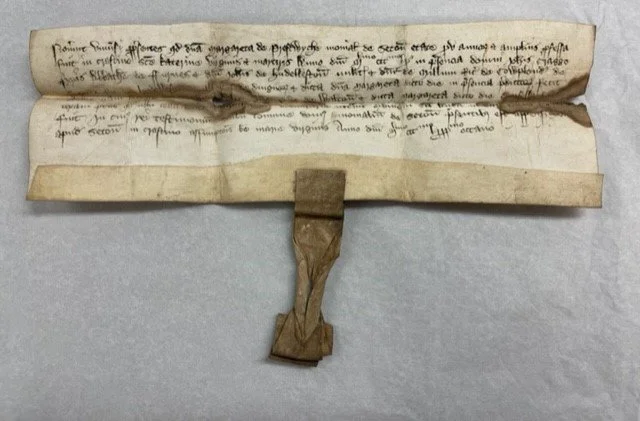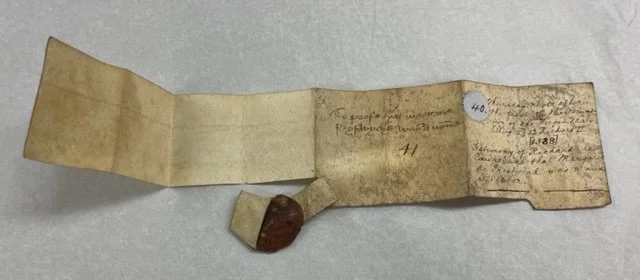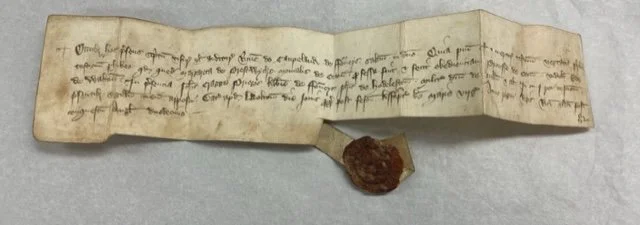Documents of Yore
As a continuation of last month’s post, let us briefly discuss the other large collection of documents housed at Agecroft Hall. These documents, which include things like indentures, bonds, wills, and pardons, all concern Agecroft Hall lands and family in England from the late 1200s to the early 1800s. The deeds are written in different languages—Latin, Norman French, and English—and were hand printed on vellum or parchment. Many of the deeds still boast their wax seals. These documents were first catalogued, dated, and transcribed in 1886 by a scholar named J.P. Earwacker. Using these documents, the reader can pull out a history of the lands, manor houses, and families who called Agecroft home for nearly five centuries.


One particularly captivating story that can be traced through these documents is the 14th century story of Margaret Prestwich, the nun…or not! Orphaned at a young age, Margaret and her sister, Agnes, became wards of Richard de Radcliffe whose job it was to oversee their properties until they came of age and to ensure that they made good marriages. In return, de Radcliffe was handsomely compensated. However, the value of his fee paled in comparison to the value of the land the girls were to inherit, a fact that was not lost on Richard de Radcliffe, as he was leasing one of their properties. The two girls followed two different paths, and questions related to their inheritance rights quickly followed. While the milestones of their lives are clear, the motivations behind their choices (if, indeed, they were their choices) were hotly debated through legal and liturgical channels for nearly 50 years! Agecroft is lucky to have many of the documents related to the controversy that ensued.
The debate was rooted in the fact that Margaret entered a convent at a very young age clearing the way for her sister Agnes to inherit all the properties. Agnes, on the other hand, married a member of the de Radcliffe family, which should have guaranteed that the family leasing the property became the landowners themselves. Were these coincidences? Did the young girls make conscious choices? Alternatively, did Richard de Radcliffe use the girls as pawns in a power play to secure his own family’s financial future?


We may not know the answer for sure, but the documents in Agecroft’s collection offer some intriguing insights. Agnes died young and childless and so the property reverted to her aunt, Joan de Langley, and her descendants. Almost immediately, Margaret left the convent and quickly married the swashbuckling Robert de Holland. The pair returned to her home to claim her inheritance. For the next few decades, the de Hollands and the de Langleys fought for control of the property through a combination of legal challenges, appeals to the Church and vigilante justice. Legally, the right to inherit her father’s properties hinged on the question of whether Margaret had willingly taken her final vows. Agecroft’s documents offer contradictory judgements. Some sources state that she was coerced against her will. Others state that she made her vows voluntarily. Meanwhile Margaret’s husband periodically resorted to criminal activities to advance his cause. Kidnapping the de Langley’s cattle and extorting the local vicar resulted in more legal trouble, which is also recorded in the documents.
Accusations and violent recriminations are woven through these documents, When examining the evidence in Agecroft’s documents, it is as important to consider who is making the statement and what motivation they may have for their opinion as well as what the document states. No one appears to be entirely virtuous. In the end, there is no clear answer, but one can certainly flesh out several scenarios and consider which ones are more likely. Given that the properties, including the land on which Agecroft Hall would later be built, descended through the Langley family to the Dauntesey family, you can easily guess which family was ultimately the victor.
The artifacts in Agecroft offer us glimpses into the general practicalities of life in a Tudor manor house, but the documents - which might seem uninteresting at first glance - actually tell specific stories about the individuals who lived in and around Agecroft. Next time you visit Agecroft, you may want to take a longer look at some of the documents on view on the second floor.
